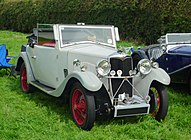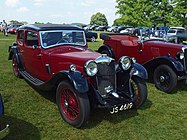Motor vehicle
| Riley 12/6 | |
|---|---|
 Riley 12/6 Lincock fixed head coupé Riley 12/6 Lincock fixed head coupé | |
| Overview | |
| Manufacturer | Riley |
| Production | 1932–1935 |
| Designer | Percy and Stanley Riley |
| Body and chassis | |
| Body style | 4-door saloon 2-door coupe 2-door convertible |
| Powertrain | |
| Engine | 1.5 L Straight-6 |
| Dimensions | |
| Wheelbase | 114 in (2,896 mm) |
| Chronology | |
| Predecessor | None |
| Successor | Riley 12/4 |
The Riley 12/6 was a car made by the British Riley company from late 1932 (for the 1933 model year) to 1935.
It had a 1458 cc straight-six engine with twin cams and either single, twin or triple SU carburettors. The transmission was either a four speed manual or optional preselector gearbox. They were capable of a top speed of around 70 mph (113 km/h). The chassis was a lengthened version of the one used on the Riley Nine.
They were available in a range of models: Mentone saloon, Kestrel saloon, Lincock fixed head coupé, Ascot drophead coupé with dickey seat, Lynx tourer, Falcon saloon, Gamecock tourer, March two-seat tourer, MPH two seater trial/sports 2-seater, and Trinity 3-position Drophead Coupé.
The 12/6 engine was designed to fit in between the 9 and 14/6 engines for trialing and racing purposes. The 9 was 1087 cc, fitting in the 1100 cc class, and the 14/6 was 1633 cc, fitting in the over-1500 cc class. A 1486 cc "Brooklands Six" was developed to compete in the sub-1500 cc International Class F, with two or three cars built in mid-1932. Another such engine was fitted to an Alpine Tourer for the 1932 Monte Carlo Rally, where it finished second in class. The 1458 cc 12/6 was derived from the Brooklands Six. The slightly larger "Brooklands" engine continued to see some limited use, such as in the 1933 Riley Grebe prototype and in the TT Six.
As the 14/6 was basically a 9 with two extra cylinders on the end, the 9 and 14/6 engines shared the same parts and spares. The 12/6 didn't share parts with any other Riley, so many 12/6s have been bored out to the size of a 14/6 to compensate for spares. All of these engines share the same 95.2 mm (3.75 in) stroke. The 12/6 has a 57 mm (2.24 in) bore, while the "Brooklands" competition engine has a 57.546 mm (2.27 in) mm bore.
Gallery
References
- ^ Culshaw; Horrobin (1974). Complete Catalogue of British Cars. London: Macmillan. ISBN 0-333-16689-2.
- ^ "Riley 1933". Classic Car Catalogue. Archived from the original on 9 August 2020.
- "Riley 1932". Classic Car Catalogue. Archived from the original on 13 December 2020.
- Hamberg, Erik (1998). "Rileys svenska Monte Carlo-historia" [Riley's Swedish Monte Carlo history] (PDF). Rileybladet (in Swedish). 20 (2). Svenska Rileyregistret: 1. Archived from the original (PDF) on 13 December 2020.

